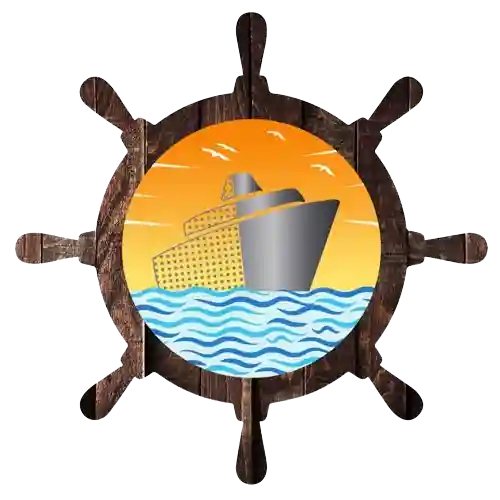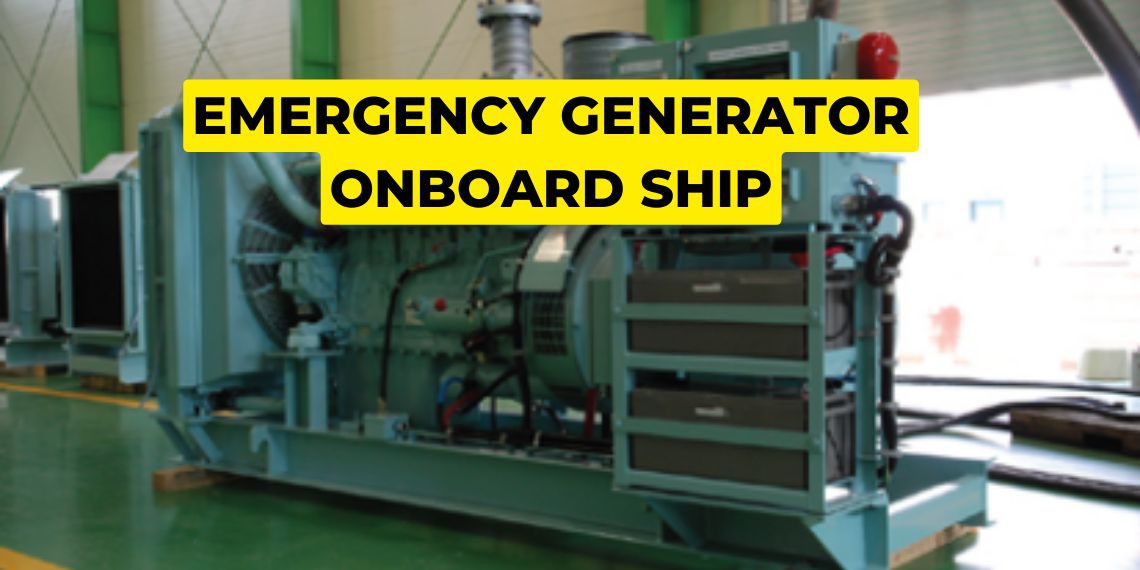Emergency generator onboard ship
A emergency generator onboard a ship is a device that is used to provide electrical power whenever the main generator is not working. Ships require a constant and reliable supply of electricity to operate various systems, equipment, and services on board, such as lighting, navigation instruments, communication devices, pumps, radar system and more. Marine generators serve the purpose of generating electrical power to meet these demands.

In your home you are using lights, fan, AC and many more devices because you are getting electricity from the electricity board. Now let us assume there are three large generators fitted in the electricity board. Say No 1 generator is running suddenly due to some reason No 1 generator falter’s and immediately stops working. Now what happens is the first standby generator that is No 2 generator will start automatically and take the load, so that it can supply electricity to your home. But due to some reason it can also not start then the second standby that is the third generator will start and take the load but even that is not working.

So common problem can arise in the generators say the fuel quality is bad or water is present with fuel, so all the three generators are not able to start. So what happens is there is no supply of electricity at my home but I have got an Inverter for backup, so immediately the light goes the inverter will take on load. This same phenomenon happens onboard ship as well, the electricity board that supply electricity to your house is like the three main generators fitted onboard ship. So if in case there is fire in engine room the generators cannot be started, if there is flooding in engine room the generators will not work, if there is bad fuel then also generators cannot be started anymore. So in that case if all the three generators are not working what will happen is there will be a complete blackout onboard ship and nobody will be able to see anything. It is in this case like an inverter in house similarly onboard ship we have emergency generators fitted.
Emergency generators as soon as it senses that the power supply has stopped then emergency generators which are smaller generators fitted outside the engine room automatically starts and there is a requirement that is within 45 seconds it will come on load. That means if there is no power supply within 45 seconds all the equipment’s will get power by the emergency generator and that is why it is one of the life lines onboard ship. The main engine generator has a capacity of running on full load up to 18 hours, so we have got a diesel oil tank which has diesel for 18 hours. Every week we have to try out the generator and every three months we have to take this generator on load and monitor performance.
Equipment’s powered by emergency generator are:
A. Equipment using 440 volt:
- Engine room fan
- Control air compressor
- No 1 steering gear
- Rescue boat winch
- Life boat winch
- MDO pump starter
- Emergency fire pump
- Hypermist system
- CO2 room exhaust fan starter.
B. Emergency equipment’s using 220 volt E
- Emergency generator room fan
- Battery charger
- Water pre heater for emergency generator cooling
- Navigation lights, signal lights
- Accommodation emergency lights
- Engine room emergency lights.
- Emergency battery and a lot of other equipment’s
Note: There’s a difference between a normal light and emergency light is that the normal light has no sticker and emergency light has sticker on it.
Components of an emergency generator:
Marine Diesel Oil/MDO tank:
It has a mark and the fuel should be always above the mark for 18 hours to run the emergency generator.

Air Filters:
The combustion air for the engine is passed through an air filter, which can be of following types:

i. oil bath air cleaner
ii. dry type air cleaner (cartridge or dust collector).
Fuel filters:
Fuel filters are fitted to clean the diesel before it enters the generator engine.

Mechanical spring starter:
When the power failure takes place the emergency generator is normally started by a small electric motor which cranks the engine for starting.

Engine Sump oil:
Regularly checking the oil level in the sump is of utmost importance. This is particularly crucial for the emergency generator, which is kept in auto mode to ensure automatic starting and loading of the generator. Before starting engine operation, it is necessary to inspect the oil level on a regular basis. This practice allows for the assessment of the oil’s condition, specifically for the presence of carbon or soot particles. If such contaminants are detected in the oil, then we need to change the oil.

Radiator:
There is a radiator present which is filled with cooling water.

Pump system:
Pump system is present to provide diesel to the generator.

Leak off mechanism:
If fuel oil is leaking then the oil level in the leak off mechanism will increase and we will get an alarm i.e. let off alarm.

Main panel:
It shows us the RPM, lube oil pressure, cooling fresh water temperature, pressure and lube oil temp.

Note:
If you want to learn more about this topic, we suggest checking out our Combo package with the given link https://merchantnavydecoded.com/courses/c/ . It’s a great way to dive deeper into the subject through video explanations. This package covers all the important details and presents them in an easy-to-understand format. Watching the videos will help you grasp the topic better and make learning more enjoyable. So, we highly recommend giving our Combo package a try to enhance your knowledge on the subject.
Disclaimer :- The opinions expressed in this article belong solely to the author and may not necessarily reflect those of Merchant Navy Decoded. We cannot guarantee the accuracy of the information provided and disclaim any responsibility for it. Data and visuals used are sourced from publicly available information and may not be authenticated by any regulatory body. Reviews and comments appearing on our blogs represent the opinions of individuals and do not necessarily reflect the views of Merchant Navy Decoded. We are not responsible for any loss or damage resulting from reliance on these reviews or comments.
Reproduction, copying, sharing, or use of the article or images in any form is strictly prohibited without prior permission from both the author and Merchant Navy Decoded.



WHY FOR ONLY 18 HOURS FOR FUEL SUPPLY NOT 17 OR 19 HOURS?
Hey Amit, it is a SOLAS requirement that emergency generator should be able to at least provide power for 18 hours, not less than that for cargo ships and 36 hours for passenger ships.